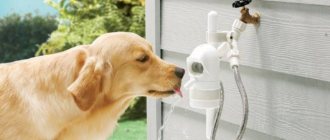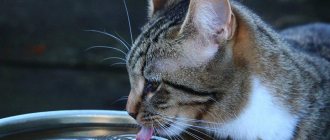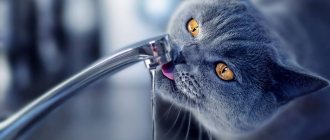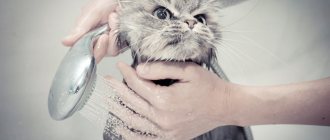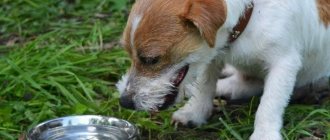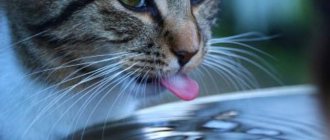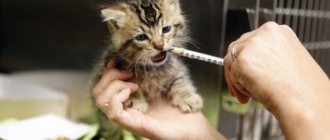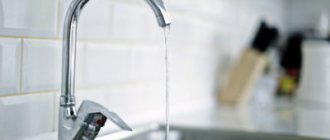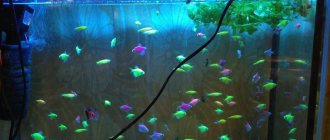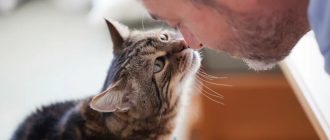5418Administration
Water plays an important role in a cat's life because its body is also more than half liquid. In nature, these animals drink less, since they receive most of their life-giving moisture from food. At home, the bulk of the diet consists of dry food, so the liquid intake should be much more. This is especially true for castrated cats, because a lack of fluid in their body provokes urolithiasis. Therefore, it is worth considering how to determine that a cat drinks little and why does this happen? This raises the question - how to get a cat to drink water?
How much water should a cat drink?
It's difficult to determine exactly how much water a cat should drink per day, as water intake varies by cat's size, time of year, general diet and age. Additionally, cats that only consume commercial food, for example, will need more water than those that regularly eat wet food.
On the other hand, kittens, immunocompromised cats and older cats need to drink more water, especially in the summer. However, as a rule of thumb, a healthy adult cat weighing about five kilograms should drink about 250 milliliters of water per day under normal conditions...
However, if you notice that your cat is drinking more water than usual , it could be a sign:
- Diabetes in cats
- AND YOU
- Thyroid problems
- Liver failure
If you notice that your cat is drinking a lot of water, we recommend consulting with your veterinarian as soon as possible to rule out the possibility of pathology. For more information, we recommend reading our article: My cat drinks a lot of water.
Several bowls
Cats are lazy by nature and if they are ready to go to the bowl for food, no matter where it is, then with water the situation is the opposite. The way out of the situation is to place several bowls of different sizes, one in each room and preferably at different heights. The pet will independently determine which one he likes best, and then those that he avoids can be removed. The main thing is not to place bowls, for example, near a vacuum cleaner or other objects that the cat is very afraid of.
5 Little-Known Facts About Cats
We recommend reading: Cystitis
The cat stopped drinking water: why?
There are many reasons that can cause a cat to stop drinking water . The most common are:
- Lack of hygiene when it comes to a bowl or dish.
- Behavior problems
- Certain pathologies, such as urinary tract infections, are common in domestic cats.
If your cat suddenly isn't drinking water and you don't know why, we recommend consulting with your veterinarian to make sure it's not an underlying condition. It's also important to recognize if your cat isn't drinking water, signs of a dehydrated cat .
Read on to find out what these symptoms are!
How to properly water a cat
The answer is clear - only water!
We know how to feed a cat correctly, but how to water it correctly?
Why does a cat need water?
A cat needs water for the normal functioning of its entire body, which consists of almost 70% of this very water. It is necessary to maintain body temperature, for digestion processes, absorption of vitamins and minerals, etc. Everything is clear with this.
BUT! Because our pets are descended from the African wild cat, they have a genetically weakened sense of thirst. Cats may drink little or even not drink at all if fed wet food.
This leads to many health problems - urine becomes concentrated, therefore, infections develop in the bladder, salts fall out and stones form, kidney function is disrupted, and the body’s water balance is upset.
Conclusion: the cat should drink enough water(!)
Enough water, how much is that?
A cat’s need for liquid is influenced by factors such as the type of food, temperature and humidity, physical activity, feeding kittens, etc. On average, a cat needs 2.5-3 times more water than the dry food it eats (for example, per 100g feed - 250g of water). Thus, the cat should always have more available water than she needs.
The quality of water is no less important. Of course, you can provide your pet with good nutrition and equally good supplements, but if the water is of insufficient quality, optimal health, alas, will not be achieved. Clean, good water is an important part of keeping your cat healthy!
Not all water is the same!
It is no secret that the quality of tap water varies greatly in different regions. Tap water usually contains sediment, chlorine and fluorine compounds, harmful impurities such as toxic residues of pesticides, heavy metals, etc., and pathogenic bacteria may also be present. In some cities, the water can even be called dangerous.
Bottled water, according to testing results, also, alas, often leaves much to be desired in terms of chemical contaminants.
Distilled water is purified so that it does not contain any particles. It may be useful for short-term use, such as during the detoxification process, but is not suitable for long-term use. Why? Chemistry + physics.
In more complicated terms, this involves the process of moving substances from an area of high concentration to an area of low concentration through osmosis.
Simply put, distilled water is an excellent solvent; it dissolves nutrients in itself, “washing” them out of the body, resulting in a deficiency of sodium, potassium and other important microelements.
Spring or well water is a better choice for drinking water if it actually comes from a good natural source.
If it is not possible to use real spring water, then filtration . Even the simplest filter significantly improves the quality of tap water by retaining harmful additives. As a last resort, tap water should sit for at least 24 hours before use.
The cat's water should always be clean(!) To prevent harmful microorganisms from growing in the drinking bowl, it must be thoroughly washed daily and the water changed. Fresh water encourages your cat to drink.
What should a cat drink from?
The cat must always have access to water, so there are certain requirements for drinking bowls. Their choice is huge: they are made from various materials, come in all sorts of shapes, regular and automatic - which one to choose?
Plastic is cheaper, but has disadvantages. Bowls made from it are lightweight and cats can move them. Over time, scratches form on them - a home for germs. In addition, some types of plastic can release harmful substances into water.
Comfortable, beautiful, stable, hygienic - bowls made of ceramics and porcelain .
Metal drinkers should only be made of stainless steel. Their disadvantage is instability; the rubberized base, unfortunately, wears out over time.
The depth and shape of the dishes depend on the characteristics of the cat (hair length, drinking style, etc.). It should be noted that cats still prefer larger containers (for example, a basin for washing floors).
Tandem bowls (two bowls, one for food and one for water, connected together) are not recommended because water can get into the food, and vice versa. When placed close together, dry food becomes moistened, and the water acquires foreign odors and impurities.
Running water Since ancient times and to this day, in nature, cats love to drink water from rivers and streams. At home, some pets also prefer a trickle of tap water.
Maybe this is due to historical roots, or maybe they just like fresh, cool water and its murmur. It's good if the tap is connected to the filter.
And if not? After all, we have already found out how harmful tap water can be.
drinking fountain will be just right .
How it works? The automatic drinker is equipped with a quiet electric motor that ensures a constant flow of purified water. And it is cleaned through a filter, usually charcoal. Thus, all the hares are killed - the water is both running and clean. This device makes water more attractive to the cat, encouraging it to drink more. A good investment in your cat's health!
Tip: To get your cat to drink more, you should interest her, for example, increase the number of water bowls and place them in unexpected places, say, on the windowsill. A curious cat may be attracted to the process of finding water ( 8 4.38 out of 5) Loading…
Source: https://CatiCat.ru/aibolit/voda.html
The cat does not drink water, but eats
If you notice that your cat is not drinking water and is showing signs of dehydration, this is a cause for concern...
Is my cat dehydrated??
A dehydrated cat will have symptoms such as:
- Decreased appetite...
- Dried gums.
- Decreased skin elasticity...
- Noticeably sunken eyes.
- Decreased body temperature..
For more information, we recommend reading our article where we discuss in more detail how to tell if your cat is dehydrated...
If your cat doesn't drink water but eats it, you can use this as a basis for rehydrating your cat. If your cat is not drinking but eating, we recommend offering wet cat food to replenish lost electrolytes. For more information, read our article where we list the best home remedies for dehydrated cats.
Fountain for cats
Cats love to drink "live" water that comes from the tap, but most people can't leave the tap open all day, because then the utility bill will be very impressive. The ideal solution for a cat who fundamentally wants to drink only flowing water is to buy a pet fountain. The pet will be able to play with the stream and get plenty of water whenever he wants. But be sure to keep the fountain clean and fill it with fresh water every day.
Using these tips, you can train your cat to drink water, which is so important for its health. But if you have a very wayward pet, try adding catnip, which you can drop directly into the bowl. Or switch to wet food, which does not require your cat to receive additional liquid.
We recommend reading: Why people become attached to cats
How to get your cat to drink water when she's sick
Your sick cat doesn't drink water?? ? In the case of a sick cat, your veterinarian will often suggest offering your cat water through an unnecessary syringe. But how do you apply electrolyte solution to cats?
The first thing to do is buy a syringe from a pharmacy (without a needle). Make sure you have someone to help you restrain your cat to avoid undue stress and anxiety for your cat. If your cat moves around excessively, gently wrap him in a towel.
Then slowly feel your cats jaws and find their fangs. Add light pressure with your index finger and thumb, which should gently force your cat's mouth open. From here, offer water carefully.
Move away from the food bowl
In the wild, cats eat prey, and some of the remains are left to rot on the ground, which leads to infection of everything nearby. Cats are accustomed to looking for water away from food, so the first thing to do is move the water bowl away from the food.
It is possible that the cat simply does not like the fact that water from a nearby bowl gets into the food when lapping. Because of this, it begins to swell, changing its consistency and smell, so the animal tries not to drink from the neighboring plate so as not to spoil its food.
Nibelung cats: description of a rare breed
Veterinarian advice
Veterinarians advise carefully monitoring your domestic cat's daily drinking habits. This will allow you to notice a lack of water in the early symptoms of dehydration and even prevent the development of urolithiasis. Those who feed their pet dry food should be especially careful. It is worth remembering that such a diet increases the chances of developing urolithiasis. Veterinarians' advice on how to get a cat to drink water is quite simple:
- Change the water in the bowl up to 2 times a day.
- After each water change, the container must be thoroughly washed.
- Select several bowl options and give the animal a chance to choose the one he likes.
- Give your cat only spring or bottled water.
- Do not give boiled, tap or mineral water.
- Place the bowl away from the one from which the animal eats.
It is also necessary to remember that when eating dry food, the cat’s need for clean water doubles. Therefore, you should always monitor the amount you drink and monitor the cleanliness of the bowl.
If your cat drinks too much water
Sometimes, the cause for concern may not be that your pet is drinking too little water, but vice versa. A bad sign would be his suspiciously strong thirst. This can happen after prolonged exposure to the sun or excessive salt intake. Fortunately, such reasons are easily eliminated. You just need to pour more clean water into the cat’s bowl and wait until he drinks enough. If the thirst began without any reason, you need to be wary. An urgent need for large amounts of water can become a symptom of diseases such as diabetes, hyperthyroidism and many other pathologies. If your pet's thirst does not stop for several days, you should immediately contact a veterinary clinic.
Ways to determine the amount of water you drink per day
Checking how much water your cat has drunk per day is quite simple. To calculate, you need to pour a little more water into a measuring cup than required by weight, taking into account evaporation, and then pour it into a bowl.
After 24 hours, the remaining liquid must be poured back into the measuring cup and subtracted from the original volume. If the amount of liquid drunk is slightly below normal, the owners have no reason to worry.
Determining the amount of water you drink
Important! It is necessary to carry out such a test for at least 3 days, since for various reasons the need for water at different times may differ.
During the experiment, it is necessary to completely exclude the pet’s access to places where the cat usually drinks water. If there are several cats living in the house, you will have to isolate them from each other while the measurements are being taken.
What kind of water does a cat need?
Before getting a pet, you need to remember that you will have to feed and water it only with the highest quality products. This can be natural food or food from a good manufacturer. Regardless of the choice of food for a cat, every owner must provide the animal with clean and fresh drinking water. Veterinarians do not recommend giving your cat tap water. They claim that it will be healthier for the animal to drink spring or filtered water, since tap water contains a large amount of chlorine, metal salts and dirt. Boiled water does not have any beneficial substances.
The importance of water for an animal
The body of every creature consists of cells that are filled with liquid by 80%. They need their own set of microelements, which enter them only when dissolved in water. When a cat does not receive the required amount of water, this leads to negative changes in the body. Drying, hypotrophy, and in the most advanced cases, the death of living cells begins.
The required amount of water that a cat should drink daily is essential for the normal functioning of the circulatory system. Otherwise the blood becomes too thick. And in this form, it is more difficult for the heart to pump, which affects the delivery of oxygen to the muscles and various tissues. The heart and all vital organs of the animal suffer from a lack of water. Lack of oxygen also affects brain activity.
Clean water also has the ability to alleviate the condition of a sick animal. Suffering from an illness, a cat may not eat anything, but it should always drink water. Not every owner knows how to force a cat to drink water when the pet is sick and constantly sleeps. Sometimes the only option is to carefully inject water from a syringe. To do this, you need to sit the cat on your lap, remove the needle from a small syringe and gradually pour water into his mouth.

